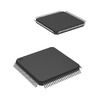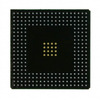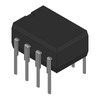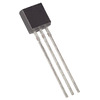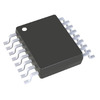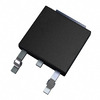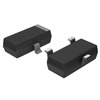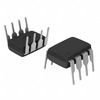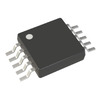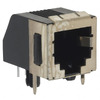LM393M Comparator: Alternatives, Features, and PCB Layout Tips
In the world of electronic circuits, precision and efficiency are key, and the LM393M comparator stands as a basic component in achieving both. This article explores the initial aspects of the LM393M, a highly versatile comparator IC widely used in applications requiring reliable voltage comparison. Renowned for its adaptability, the LM393M supports both single and dual power supplies, making it a go-to solution for hobbyists alike. As we dig deeper into its features, substitutes, and practical applications, this article will highlight how the LM393M remains a standout choice for precision electronics, offering examples and design tips to enhance its integration into your projects.Catalog
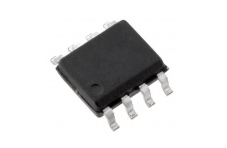
Understanding LM393M Comparator
The LM393M comparator IC is renowned for its adaptability, accommodating both single and dual supply modes while integrating two precision comparator op-amps. It operates over a wide supply voltage range and features minimal current draw, making it a compelling choice for various digital circuit applications. This IC is mostly adept at managing transistor control and logic systems, with TTL-level outputs meeting standard interfacing needs. The maximum output current of 20mA provides ample capacity for numerous applications.
The LM393M stands out due to its distinctive feature set, making it a preferred selection for many electronic projects. Its dual-mode flexibility proves invaluable during both design phases and functional implementation, especially in power management scenarios. Furthermore, its precision and efficiency in current consumption contribute to optimizing the performance and longevity of digital circuits. These attributes are mainly beneficial in professional engineering contexts, where reliability and precision are imperative.
Substitutes and Comparable
• LM393MX
LM393M Comparator Symbol, Footprint, and Pinout

Pin Configuration and Functions
• Pin 1 (OUTPUT1): This pin serves as the output for the first operational amplifier (op-amp). Reflecting the comparator’s output as a digital signal, it responds keenly to the input voltage levels, capturing the essence of electrical signals with precision.
• Pin 2 (INPUT1-): Acting as the inverting input of the first op-amp, this pin plays a poignant role in determining the exact point at which the comparator switches states.
• Pin 3 (INPUT1+): As the non-inverting input of the first op-amp, contrasting with Pin 2, this pin sets the reference voltage. It’s like a silent judge, constantly comparing the input signal.
• Pin 4 (GND): This ground pin, a steadfast common reference point, keeps the entire circuit grounded in stability and reliability.
• Pin 5 (INPUT2+): Serving as the non-inverting input of the second op-amp, much like Pin 3, this pin is dynamic for the second set of inputs' assessments.
• Pin 6 (INPUT2-): The inverting input of the second op-amp works in tandem with Pin 5. Together, they script the narrative of the second comparator’s output state.
• Pin 7 (OUTPUT2): The output of the second op-amp mirrors the function of Pin 1, but concerning the second comparator circuit, reflecting with equal fidelity the tale of electrical fluctuations.
• Pin 8 (V+): The positive supply voltage, this pin acts as the lifeblood of the comparator IC, ensuring that the entire system is powered and ready for action.
Key Features of LM393M Comparator
Efficiency and Power Consumption
The LM393M comparator is recognized for its efficient power usage, drawing a minimal 0.4mA. This low consumption suggestively extends the battery life of portable devices—an aspect highly appreciated in everyday electronics.
Versatility in Input Voltage Range
With a wide input voltage range from 0 to VCC-1.5V, the LM393M supports a variety of scenarios and applications. It ensures compatibility with numerous digital logic families such as TTL, DTL, MOS, and CMOS. This broad compatibility enhances the component's adaptability, opening doors to a wide array of potential uses.
Precision and Accuracy
A notable attribute of the LM393M is its low input offset voltage, rated at ±2mV. This low offset voltage speaks to its high precision and accuracy, making it suitable for applications requiring exacting standards. Additionally, the comparator can generate a maximum output current of 20mA, effectively driving external components and proving invaluable in various demanding environments, including both industrial controls and consumer electronics.
Flexibility in Power Supply Options
From a practical standpoint, the LM393M operates efficiently on either a single power supply ranging from 2V to 36V or a dual power supply ranging from ±1V to ±18V. This flexibility in power supply options allows for seamless integration into a multitude of designs, catering to specific needs without major modifications.
Technical Specifications of LM393M Comparator
|
Product Attribute |
Attribute Value |
|
Manufacturer |
Texas Instruments |
|
Package / Case |
SOIC-8 |
|
Packaging |
Tube |
|
Length |
5 (Max) |
|
Package Width |
3.98 (Max) |
|
Package Height |
1.5 (Max) |
|
Output Type |
Rail-to-Rail |
|
Input Bias Current |
250 nA |
|
Response Time |
1.3 µs |
|
Supply Voltage |
2 V ~ 36 V |
|
Operating Temperature |
0°C ~ 70°C |
|
Operating Supply Current |
225 µA |
|
Pin Count |
8 |
|
Mounting Style |
SMD/SMT |
|
Number of Channels |
2 Channel |
|
Product Type |
Analog Comparators |
Best Practices for LM393M Layout
Power Supply Considerations
Ensure a stable and clean power supply to maintain the comparator’s performance. Use decoupling capacitors close to the power pins to filter out noise. Implement separate analog and digital ground planes if possible, to minimize interference.
Input Signal Routing
Route the input signals in a way that they are shielded from noise sources. Avoid running input traces parallel to high-speed digital lines. Keep the input trace lengths as short as possible to reduce susceptibility to noise.
Placement of Components
Position the LM393M comparator close to the signal source to minimize noise pickup. Place related components, such as resistors and capacitors, as near as possible to the comparator.
Thermal Management
Consider the heat generated by nearby components and ensure good thermal management. Ensure that the comparator is not placed near heat-dissipating devices that might affect its operation.
Signal Integrity
Ensure that the layout minimizes loops that can act as antennas and pick up external noise. Route signals in a way that maximizes their integrity and minimizes crosstalk between lines.
Practical Applications of the LM393M Comparator
The extensive functionality of the LM393M comparator is harnessed in various practical applications across different sectors. Its precise ability to compare analog signals drives its prominence. Let's explore some exact uses.
Photosensitive Circuits
In photosensitive circuits, the LM393M comparator evaluates light intensity levels by comparing outputs from a light sensor against a set reference voltage. It can trigger actions such as lighting activation. For instance, outdoor lighting systems use the LM393M to switch on lights when ambient light dips below a specified threshold. This mechanism optimizes energy consumption. Enhances efficiency and user experiences in various settings.
Battery Voltage Monitoring
The LM393M comparator plays a major role in battery management by detecting voltage drops below a predefined level. This prompts actions like power cut-off to prevent over-discharge, thus preserving battery life. Basic in consumer electronics and electric vehicles. Industrial systems incorporate it to ensure long-term reliability and performance.
Pulse Detection
Pulse detection circuits frequently utilize the LM393M for accurate evaluation of pulse signals against specified thresholds. This application is noteworthy in medical devices like heart rate monitors, ensuring precise pulse rate detection, and in diagnostic equipment and wearable tech, where high-fidelity monitoring is dangerous for patient care.
Switch Control
The LM393M comparator is basic to automation and motor control through the effective comparison of input signals to reference voltages, thereby regulating switches or relays. Controls conveyor belts in industrial automation based on sensor inputs. Manages lighting and HVAC systems in smart homes, enhancing comfort and energy efficiency.
Motor Control
Utilizing the LM393M in motor control systems allows for meticulous regulation of motor activities based on sensor feedback. Controls fan speeds in HVAC systems. Manages robotic operations in manufacturing, ensuring motors operate within desired parameters. Continuously compares sensor inputs to reference values, identifying potential issues early.
Enhancing LM393M Comparator Performance
Optimize Bandwidth
Refining the layout and routing of the circuit forms the initial path toward optimizing bandwidth. High-speed applications benefit immensely from RC filters, which help mitigate noise and enhance signal integrity. Experience in RF design suggests that meticulously controlling trace length and grounding can refine high-frequency signal performance. Furthermore, a well-thought-out PCB design can minimize parasitic capacitance and inductance, ensuring quicker and more reliable data transfer.
Increase Gain
Adjusting the feedback resistor value can effectively increase the gain of the LM393M comparator, provided that accuracy is maintained. Selecting high-precision resistors and designing an appropriate feedback network is dangerous. Practical examples from signal amplification demonstrate that incremental adjustments offer the best opportunity to balance gain and accuracy, allowing for fine-tuning in a controlled environment.
Improve Linearity
Enhancing linearity often necessitates adjustments to the bias current and static operating point. By carefully selecting components to provide stable operating points under varying conditions, greater accuracy can be realized. In analog circuit design, maintaining consistent bias currents is widely recognized as a method to reduce non-linear distortions, frequently observed in the audio amplification industry. Flexible biasing techniques contribute to a smoother transfer function, thereby improving linearity and overall system performance.
Reduce Power Consumption
Reducing power consumption involves choosing suitable devices and optimizing the design to lower the bias current. Low-power components should be used whenever feasible. Modern electronics, mostly portable device designs, prioritize minimizing power consumption to extend battery life. Practical experimentation and iterative refinements demonstrate that low-power designs can reduce thermal noise and enhance efficiency, contributing to prolonged device operation and improved performance.
Minimize Offset Voltage
Achieving better accuracy through minimizing offset voltage relies heavily on using high-quality resistors and fine-tuning layout and wiring practices. Precision resistors play a substantial role in reducing thermal drift, thereby stabilizing offset voltage. In practical terms, professional PCB design standards recommend employing symmetrical layouts and short, direct paths for signal routing. These methods are instrumental in achieving a lower, more stable offset voltage, ultimately elevating comparator performance.
Frequently Asked Questions [FAQ]
1. What is the replacement and equivalent of LM393M?
You can replace it with LM393MX/NOPB, LM393M/NOPB, and LM393MX.
2. What is the LM393M?
The LM393M is a precision voltage comparator IC widely employed for comparing two input voltages and delivering a clear digital output signal. Its reliability and versatility have through the years made it requisite in numerous electronic designs.
3. What is the Operating Temperature Range?
The LM393M functions effectively within a temperature span of 0°C to 70°C. This range covers a majority of general-purpose applications, ensuring consistent performance across standard environmental conditions. Practical application examples often involve the usage of temperature control systems to maintain optimal operational ranges for various electronic devices, contributing to prolonged lifespan and reliability.
4. What are common applications for the LM393M?
The LM393M is frequently utilized in window comparator circuits, threshold detection systems, and voltage protection circuits. These applications benefit from its precise voltage comparison capabilities. For example, in voltage protection circuits, the LM393M can effectively monitor voltage levels, triggering protective measures when thresholds are exceeded, a major function in safeguarding sensitive electronic components.
5. Can the LM393M be used with a single power supply?
Indeed, the LM393M can operate with either single or dual power supply configurations, providing a breadth of design options and adaptability.
This flexibility simplifies its integration into various system architectures, accommodating different power supply requirements without extensive modifications. Many practical applications leverage this feature to design power-efficient circuits for portable electronic devices, ensuring efficient power management while maintaining functionality.
About us
ALLELCO LIMITED
Read more
Quick inquiry
Please send an inquiry, we will respond immediately.

ULN2003AD Alternatives, Circuit Design, Functionality, and Layout
on September 27th
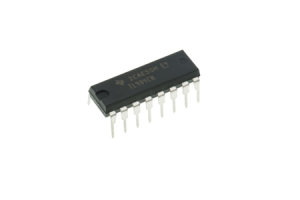
TL494CN PWM Controller: Pin Layout and How it Works?
on September 27th
Popular Posts
-

What is GND in the circuit?
on January 1th 3117
-

RJ-45 Connector Guide: RJ-45 Connector Color Codes, Wiring Schemes, R-J45 Applications, RJ-45 Datasheets
on January 1th 2678
-

Understanding Power Supply Voltages in Electronics VCC, VDD, VEE, VSS, and GND
on November 15th 2220
-

Fiber Connector Types: SC Vs LC And LC Vs MTP
on January 1th 2185
-

Comparison Between DB9 and RS232
on January 1th 1804
-

What Is An LR44 Battery?
Electricity, that ubiquitous force, quietly permeates every aspect of our daily lives, from trivial gadgets to life-threatening medical equipment, it plays a silent role. However, truly grasping this energy, especially how to store and efficiently output it, is no easy task. It is against this background that this article will focus on a type of coin cell battery that may seem insignificant on the...on January 1th 1778
-

Understanding the Fundamentals:Inductance Resistance, andCapacitance
In the intricate dance of electrical engineering, a trio of fundamental elements takes center stage: inductance, resistance, and capacitance. Each bears unique traits that dictate the dynamic rhythms of electronic circuits. Here, we embark on a journey to decipher the complexities of these components, to uncover their distinct roles and practical uses within the vast electrical orchestra. Inductan...on January 1th 1730
-

CR2430 Battery Comprehensive Guide: Specifications, Applications and Comparison to CR2032 Batteries
What is CR2430 battery ?Benefits of CR2430 BatteriesNormCR2430 Battery ApplicationsCR2430 EquivalentCR2430 VS CR2032Battery CR2430 SizeWhat to look for when buying the CR2430 and equivalentsData Sheet PDFFrequently Asked Questions Batteries are the heart of small electronic devices. Among the many types available, coin cells play a crucial role, commonly found in calculators, remote controls, and ...on January 1th 1680
-

What Is RF and Why Do We Use It?
Radio Frequency (RF) technology is a key part of modern wireless communication, enabling data transmission over long distances without physical connections. This article delves into the basics of RF, explaining how electromagnetic radiation (EMR) makes RF communication possible. We will explore the principles of EMR, the creation and control of RF signals, and their wide-ranging uses. The article ...on January 1th 1672
-

Comprehensive guide to hFE in transistors
Transistors are crucial components in modern electronic devices, enabling signal amplification and control. This article delves into the knowledge surrounding hFE, including how to select a transistor's hFE value, how to find hFE, and the gain of different types of transistors. Through our exploration of hFE, we gain a deeper understanding of how transistors work and their role in electronic circu...on November 15th 1637
